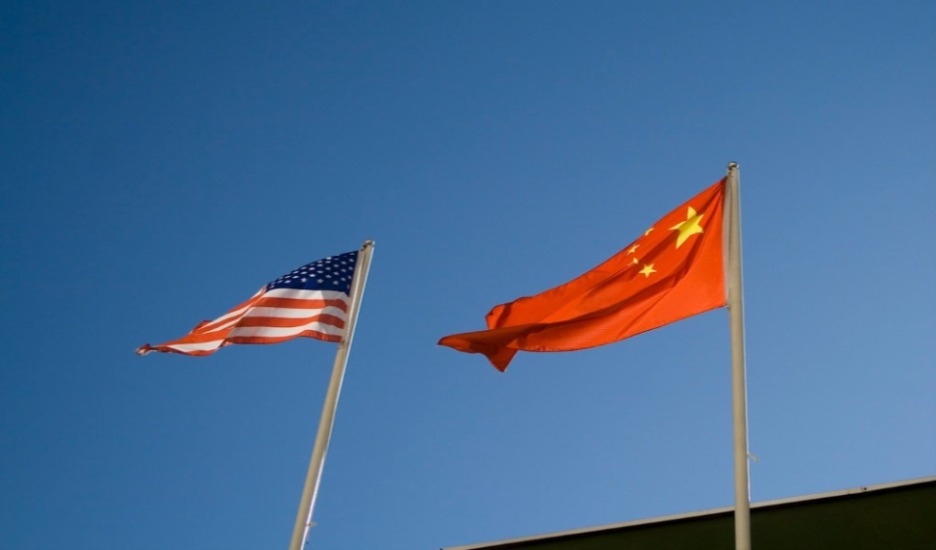Water Wars: Mr. Duterte Goes to Beijing
Details of a Deal Emerge between Manila and Beijing
President Xi Jinping welcomes President Rodrigo Duterte to Beijing (Photo: Straits Times)
Published by The Lawfare Institute
in Cooperation With

Details of a Deal Emerge between Manila and Beijing
President Xi Jinping welcomes President Rodrigo Duterte to Beijing (Photo: Straits Times)
Philippine President Rodrigo Duterte’s still-nascent tenure has sent shockwaves throughout the Western Pacific. This week was no different as President Duterte made a much-anticipated state visit to Beijing. Though a number of memoranda of understanding were signed, reports are still coming in as to what exactly has been agreed upon. Though differences in South China Sea were discussed, it appears that the arbitral tribunal decision was not specifically raised. Here’s what we know so far.
There was a fever of speculation about whether, and how, President Duterte would address Manila and Beijing’s conflicting claims in South China Sea during his trip. On Sunday, President Duterte initially suggested that he would take a relatively strong position on these issues, asserting that, “I will not bargain anywhere, we will continue to insist that [Scarborough] is ours” before adding that “the arbitral tribunal decision will be taken up.” Chinese Foreign Ministry spokesperson Hua Chunying minimized these statements, noting that “President Duterte has been expressing his positive intention of having dialogue with China and properly dealing with relevant issues.”
Ms Hua’s prognosis doesn’t appear to be too far off the mark. When Duterte arrived in Beijing on Tuesday he announced that the arbitral decision would “take the back seat” and that he would wait for Chinese officials to bring up South China Sea disputes. He claimed that this was “a matter of courtesy, and the oriental way.” President Duterte also asserted that, “it’s only China [that] can help us.” Though officials say that it is still necessary to “iron out details,” five topics emerged (some addressed in memoranda of understanding, some more informally) as key areas for future discussion on the South China Sea. As more reports trickle in we will have a better idea about what these agreements might mean for China’s compliance with the arbitral decision. See this statement for an official account of what was discussed during Duterte’s visit.
First, Chinese sources indicate that Beijing is considering allowing Filipino fishermen conditional access to waters in and around Scarborough Shoal. Philippine fishing vessels have been denied access to these waters since it was seized by China in 2012. The arbitral tribunal declared that Chinese and Filipino fishermen both have traditional fishery rights in the area. Ambassador Zhao was optimistic about a fisheries deal, acknowledging that, “we know President Duterte is concerned about fishermen and we have the market and we have the capital and we have the interest.” Later in the visit, however, a senior Chinese diplomat said that President Xi and President Duterte had not discussed this issue.
Second, Manila-based The Inquirer reports that officials are in talks to finalize a deal on joint oil or natural gas exploration near Reed Bank, controlled by the Philippines, in the South China Sea. Sources caution, however, that “the issue of sovereignty will not be touched.” It is unclear how far these discussions have progressed and whether they were finalized in a memorandum of understanding (MOU). The next day, for example, President Duterte said that joint oil exploration “has to be with the consent of Congress” and that he is “not empowered to do that.”
Third, Trade Secretary Ramon Lopez announced that the MOUs finalized $13.5 billion in trade deals on projects ranging from infrastructure to trade and tourism. The Philippines also received a $9 billion low-interest loan, a third of which will come from private Chinese banks. $15 million of the loan is expected to go towards drug rehabilitation programs. Fourth, Vice Foreign Minister Liu Zhenmin told reporters that a separate MOU established a joint committee for communication between the Chinese and Philippine Coast Guards and provided for bilateral defense cooperation in areas of “humanitarian assistance and disaster alleviation and peacekeeping operations.” It is unclear what this committee and these discussions will specifically address.
Finally, Presidents Xi and Duterte agreed to begin bilateral negotiations to resolve their maritime disputes. In their official statement, both sides announced that bilateral consultations “will meet regularly on current and other issues of concern to either side of the South China Sea.” These consultations would be “without prejudice to other mechanisms.” Given that the Philippines has insisted only on multilateral negotiations for the six years prior to Duterte’s presidency, this may be the most important agreement to arise from this visit.
President Duterte ended his trip by giving a speech that was, once again, sharply critical of the United States. He began by “announc[ing] my separation from the U.S.” before a room of business leaders, saying that he might also go to President Vladimir Putin and tell him “there’s three of us against the world.” President Duterte went on to argue that, “both in military, not maybe social, but economics also. America has lost.” Not one to stop when on a roll, President Duterte went on to say that “Americans are loud, sometimes rowdy” and that “They are a very discourteous people.” US State Department spokesperson John Kirby responded that Washington was “baffled” by Duterte’s statements, as they were “inexplicably at odds with the very close relationship that we have the Filipino people, as well as the government there.” White House Press spokesperson Eric Schultz made much the same point, telling reports that the United States has not received any requests to alter bilateral cooperation.
It is unclear how the results of this trip, and President Duterte’s speech, will play with Duterte’s domestic constituency. Fishermen who traditionally operate near Scarborough Shoal are skeptical of a rapprochement with China, arguing that “we don’t know what China will do with our territories if we allow them to set conditions that Filipinos must follow.” A survey conducted in September also found that 55% of Filipinos have “little trust” in China while 76% have “much trust” in the United States. It also unclear the extent to which President Duterte’s cabinet agrees with his stance towards the United States. Just last week Foreign Secretary Perfect Yasay said that Washington is “our only military ally. You could not put the US, in that sense, in equal footing with China.” Defense Secretary Delfin Lorenzana also seems out of step with Duterte. At a Commission on Appointments hearing, Secretary Lorenzana claimed that, “the President has been issuing statements without consulting the Cabinet.”
What does this mean going forward? On the one hand, the Duterte administration has said it wants to formally join the Asian Infrastructure Investment Bank, established by Beijing last year. The Global Times, a Chinese government-run publication, is also bullish about prospects for Philippine-Chinese relations. Scholars, however, are more conflicted. Javad Heydarian at QZ examines the sometimes-contradictory strains of Duterte’s foreign policy and explores what it might mean for US-Philippine relations. Former Foreign Secretary Albert del Rosario also voiced skepticism about the probity of President Duterte’s new relationships with the United States and China. Renato Cruz de Castro at AMTI, however, is less concerned, arguing that Manila’s continuing relationship with Tokyo will provide ballast in the region. Notwithstanding the merits of Duterte’s policy choices, it is worth revisiting Andrew Erickson’s piece at The National Interest on the challenges of maintaining US security ties in a region experiencing significant domestic political change.
In other news...
United States
At long last, and seemingly without technical flaws, the first U.S. Littoral Combat Ship (LCS) to arrive in Southeast Asia is combat ready. The LCS is a new class of ship designed to be smaller, faster, and more versatile than existing naval vessels. This LCS, the USS Coronado, will be based out of Singapore.
Assistant Secretary of State for East Asian and Pacific Affairs Daniel Russel, speaking to Breaking Defense, said that the United States does not necessarily, “announce every FONOPs [freedom of navigation operation], so some things are visible; some things are only visible to people with radar and tracking.” He added that, “the Chinese are not being let off the hook.”
US defense cooperation in the region continued apace this week, according to news out of New Zealand and Vietnam. First, Wellington ended a 30-year hiatus on visits by US naval vessels, triggered by a ban on nuclear warships in New Zealand ports, by clearing the destroyer USS Sampson to visit during the Royal Navy’s 75th anniversary. The ban has not changed; instead, Prime Minister Key has apparently been assured with “100 percent confiden[ce]” that the USS Sampson isn’t nuclear powered or carrying nuclear weapons. The Sampson will not be alone; China is dispatching the Yancheng, a guided-missile frigate, to attend as well.
Second, senior Vietnamese and US officials discussed opportunities for greater defense cooperation. Both sides pledged to increase personnel exchanges, cooperation in marine security, humanitarian aid, UN peacekeeping missions, and expand support for repatriating remains from the Vietnam War.
China
President Duterte’s visit wasn’t the only news out of China this week. Beijing deployed eight domestically produced floating sensors in the South China Sea. These sensors will allow both civilian and military users to monitor the South China Sea up to a depth of two kilometers. Though these sensors are part of an international civilian project, Macau-based military analyst Anthony Wong Dong argued that they would help the Chinese military more readily deploy submersibles. Some analysts also assess that the sensors will give the People’s Liberation Army the ability to counter U.S. attack and ballistic missile submarines.
Last week’s run-in between Chinese fishermen and the South Korean Coast Guard continued to send shockwaves across the Yellow Sea. The Ministry of Defense released a statement that it is keeping a “close watch” on joint naval exercises between the United States and South Korea taking place this week in Korean waters. The Ministry urged “related parties to keep calm and exercise restraint” to avoid escalating tensions in the region.
The Philippines
News wasn’t any quieter in Manila. Supreme Court Senior Associate Justice Antonio Carpio warned that, “if Duterte conceded sovereignty [over Scarborough Shoal], it is a culpable violation of the Constitution, a ground for impeachment.” He further alleged that, “only an international court can void the concession (that Duterte might give to China). (And) China will never submit to the jurisdiction of an international court on sovereignty issues.” Majority Floor Leader Rodolfo Fariñas responded that Justice Carpio “spoke out of turn” and acted in a manner “unbecoming” of a Supreme Court Justice.
In other news, Defense Undersecretary Eduardo del Rosario, responding to a Senate Committee inquiry, denied reports that China is building at Scarborough Shoal.
Vietnam
Developments out of Hanoi show the difficult path regional actors have to tread in navigating between the United States and China. Last week Foreign Ministry spokesperson Le Hai Binh asserted that “Vietnam’s consistent policy is not to engage a military ally,” meaning that “we will also not allow any other countries to set up a military base in Vietnam.” Nevertheless, Vice-Defense Minister Nguyen Chi Vinh said that Hanoi supports United States “intervention” in the Asia-Pacific if it helps keep peace and stability. For the time being, however, three Chinese warships will dock at Vietnam’s strategic naval base at Cam Ranh Bay this Saturday, just three weeks after two U.S. naval vessels did the same.
Japan
The Defense Ministry released a report on Friday finding that the Air Defense Force scrambled fighter jets in response to Chinese military aircraft a record 407 times in the six months ending September 30th. Jets were scrambled 231 times in the same period last year. Foreign military aircraft never entered Japanese airspace. Notwithstanding these statistics, Government sources indicate that Tokyo intends to conclude a deal with Beijing by the end of this year on maritime search and rescue cooperation. The pact would increase joint training exercises communications links between the two maritime forces. In a similar vein, Indonesian Coordinating Maritime Affairs Minister Luhut Binsar Pandjaitan announced that Jakarta and Tokyo agreed to set up a working group on cooperation agreements, including joint oil exploration off Natuna Island.
Taiwan
Japan and Taiwan have had a longstanding dispute concerning Okinotori Atoll, a reef in the Philippine Sea. The conflict last flared up this past May when Tokyo seized a Taiwanese vessel it claimed was illegally fishing in Japan’s Exclusive Economic Zone. Taiwanese This week, President Tsai Ing-wen signaled that she would like to move beyond this dispute and instead focus on “enabling Taiwan’s fishermen to freely and operate in the surrounding waters.”
Australia
Labor Shadow Defense spokesperson Richard Marles made waves last week by saying that Canberra should allow the navy to make operational decisions as to whether freedom of navigation operations (FONOPs) in the South China Sea should be conducted. This week, however, he stepped back from this position, saying that, “a significant operation of that kind would ultimately include the approval of government.” See Euan Graham’s piece at The Interpreter for more on how this kerfuffle fits into larger policy debates in Australia and this editorial from the Wall Street Journal for a critical take on Canberra’s history, or lack thereof, with FONOPs.
Analysis, Commentary, and Additional Information
A couple of pieces this week examine the shifting landscape of strategic relations in the South China Sea. Julian Ku and Chris Mirasola at USNI News explore how China’s ambiguous compliance with the arbitral tribunal ruling might shape continuing China-Philippine negotiations. Matthew Short at the East West Institute focuses on Japan to show that what happens in the South China Sea affects the East China Sea. David Santoro and Brad Glosserman at War on the Rocks argue that deterrence, not assurance, now structures strategic relations in Asia. Theresa Fallon writes that China has successfully used “economic statecraft” to soften “the resolve of some EU member-states” regarding the South China Sea. And finally, James Fanell and Ryan Martinson explain why more open information on Chinese activities at sea is important for US strategy in the region.
Water Wars is our weekly roundup of the latest news, analysis, and opinions related to ongoing tensions in the South and East China Seas. Please email Chris Mirasola with breaking news, relevant documents, or corrections.


.jpg?sfvrsn=5a43131e_9)


